Did you know that over 300 years of Spanish colonization transformed the way food is prepared in the Philippines? This historical period introduced new ingredients like tomatoes, garlic, and onions, which became staples in many traditional dishes. The blending of Spanish and indigenous cooking methods created a unique culinary identity that continues to thrive today.
Spanish influence is evident in iconic dishes such as adobo and lechon, which showcase the fusion of flavors and techniques. These dishes highlight the simplicity of preparation while carrying a rich cultural heritage. The use of vinegar, soy sauce, and spices reflects the adaptability of local cooking to foreign influences.
This article explores how Spanish colonization shaped the evolution of Filipino cuisine. From the introduction of new ingredients to the development of cooking methods, you’ll discover how these changes have left a lasting impact on the way food is enjoyed in the Philippines today.
Key Takeaways
- Spanish colonization introduced key ingredients like tomatoes and garlic.
- Traditional dishes like adobo and lechon reflect Spanish influence.
- Filipino cuisine blends simplicity with rich cultural heritage.
- Vinegar and soy sauce became essential in local cooking.
- The fusion of Spanish and indigenous methods shaped modern dishes.
Introduction to Filipino Culinary Techniques
Every dish in the Philippines tells a story of tradition and community. The way meals are prepared reflects a deep connection to cultural heritage and family values. From simple home-cooked meals to grand celebrations, food is a cornerstone of daily life.

Overview of Filipino Cooking and Cultural Heritage
Filipino cooking is known for its simplicity and rich flavors. Common ingredients like rice, garlic, and vinegar are used in creative ways to create hearty meals. Dishes often combine meat, seafood, and vegetables, showcasing the country’s diverse resources.
Family plays a central role in meal preparation. Cooking is often a communal activity, bringing people together to share stories and traditions. Celebrations are marked by special dishes like lechon and adobo, which highlight the blend of local and foreign influences.
Purpose and Scope of This Ultimate Guide
This guide aims to explore the techniques and history behind Filipino cooking. It will cover everything from pre-colonial practices to modern adaptations. Whether you’re a home cook or a culinary enthusiast, this resource will deepen your understanding of the Philippines’ unique food culture.
By the end, you’ll appreciate how simple ingredients and methods come together to create dishes that are both comforting and memorable. Let’s dive into the world of Filipino cooking and discover its timeless traditions.
Historical Roots of Filipino Cuisine
Long before foreign influences shaped the food culture, the Philippines had a rich tradition of cooking. Early practices were deeply connected to the land and sea, relying on native ingredients and simple yet effective methods. These techniques laid the foundation for the vibrant flavors we enjoy today.

Pre-Colonial Practices and Native Ingredients
Before the arrival of foreign influences, meals were prepared using methods like boiling and roasting over open fires. Ingredients were sourced directly from the environment, including fresh seafood, wild game, and locally grown vegetables. This approach ensured sustainability and resourcefulness.
Communal cooking was a cornerstone of pre-colonial life. Families and communities gathered to prepare meals, sharing stories and traditions. This practice strengthened bonds and preserved cultural heritage. Dishes were often simple but flavorful, showcasing the natural taste of each ingredient.
Historical accounts, such as Pigafetta’s journal, highlight the sophistication of early cooking. Techniques like fermenting fish to create kinilaw or using bamboo tubes to steam rice demonstrate innovation. These methods were not only practical but also deeply rooted in the local way of life.
| Practice | Ingredients | Purpose |
|---|---|---|
| Boiling | Fish, vegetables, rice | Simple preparation |
| Roasting | Meat, root crops | Enhanced flavor |
| Fermenting | Fish, vinegar | Preservation |
The early food culture of the Philippines was a testament to creativity and adaptability. By using what was available, cooks created meals that were both nourishing and meaningful. These traditions continue to inspire modern dishes, connecting the past to the present.
Spanish Colonial Influence on Filipino Cooking
The Spanish colonial era brought a wave of change to the way meals were prepared in the Philippines. Over three centuries of colonization introduced new techniques and ingredients that blended seamlessly with local traditions. This cultural exchange created a unique culinary identity that continues to thrive today.
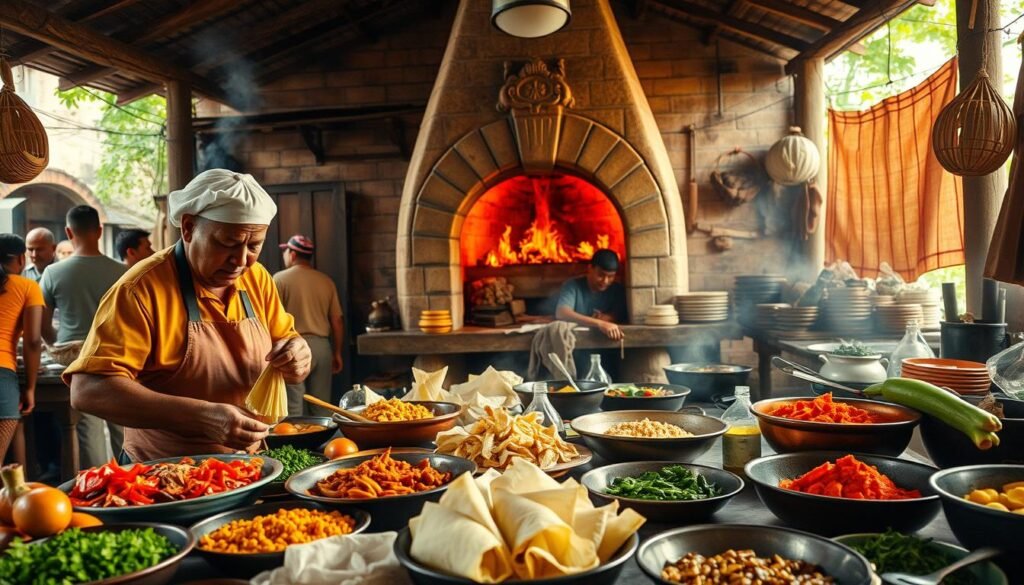
Early Encounters and Cultural Exchange
When Spanish colonizers arrived, they encountered a food culture rooted in simplicity and resourcefulness. Indigenous cooking relied on boiling, roasting, and fermenting, using ingredients like fish, rice, and vegetables. The Spanish introduced methods like sautéing, stewing, and roasting, which transformed the way meals were prepared.
One of the most significant contributions was the use of vinegar and soy sauce in marinating and preserving food. These ingredients became staples in dishes like adobo, a stew that combines meat, garlic, and spices. The Spanish also brought tomatoes, which were used in soups and sauces, adding depth to local flavors.
The blending of native and Spanish methods led to the creation of iconic dishes. For example, lechon, a roasted pig dish, became a centerpiece at celebrations. The marinating process included local spices like lemongrass, showcasing the fusion of traditions.
This period was pivotal in shaping modern Filipino food. The introduction of new techniques and ingredients fostered innovation, allowing cooks to experiment and adapt. Today, these influences are evident in everyday meals and festive dishes, reflecting a rich cultural heritage.
Exploring Filipino Culinary Techniques
From frying to steaming, Filipino cooking methods showcase a rich history of adaptation. These techniques have evolved over time, blending traditional practices with modern innovations. The result is a diverse range of methods that bring out the authentic flavors of every dish.
Traditional methods like kinilaw (marinating in vinegar) and hinurno (roasting) remain popular today. These techniques highlight the simplicity and resourcefulness of early cooks. For example, kinilaw uses vinegar to preserve and enhance the natural taste of seafood, while hinurno brings out the rich flavors of meat.
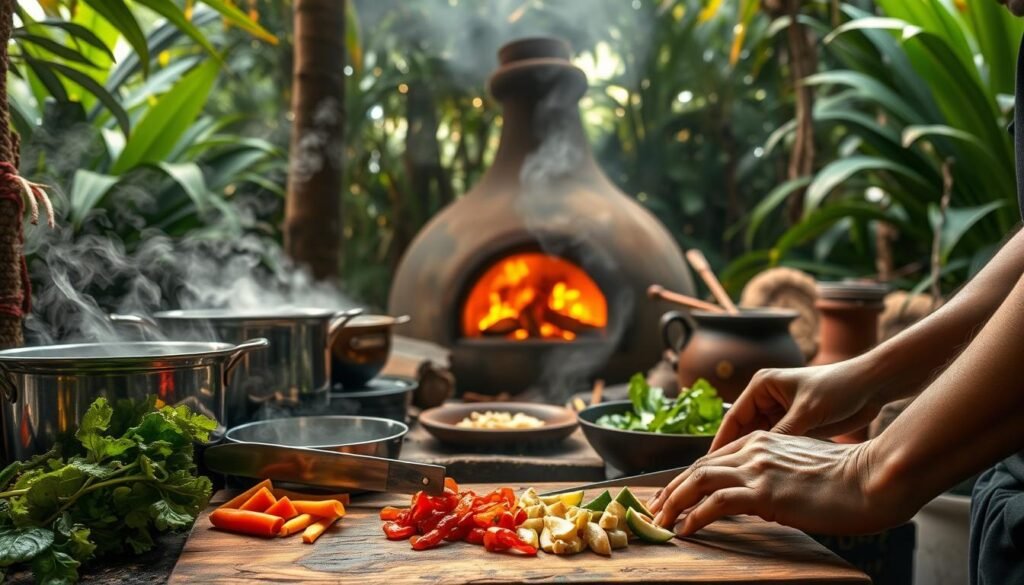
Modern chefs are reinterpreting these classic methods to create new dishes. Techniques like sautéing and braising are now common in Filipino kitchens. These methods allow for greater creativity while staying true to the roots of the cuisine.
Mastering these techniques is essential for achieving authentic flavors. Whether it’s the perfect adobo or a flavorful sinigang, the right method makes all the difference. Understanding the history behind each technique also adds depth to the cooking experience.
| Technique | Common Use | Key Ingredient |
|---|---|---|
| Kinilaw | Seafood | Vinegar |
| Hinurno | Meat | Garlic |
| Sautéing | Vegetables | Onion |
| Braising | Beef | Soy Sauce |
The evolution of Filipino cooking techniques reflects the country’s rich cultural heritage. From simple native recipes to elaborate modern interpretations, these methods continue to shape the way meals are enjoyed. By preserving these traditions, cooks ensure that every dish tells a story of history and community.
Spanish Contributions to Cooking Methods
The Spanish era introduced cooking methods that reshaped the way meals were prepared in the Philippines. These techniques, including sautéing, stewing, and roasting, became foundational in creating dishes that are now staples in local cuisine. The blending of Spanish and indigenous practices led to a unique culinary identity.
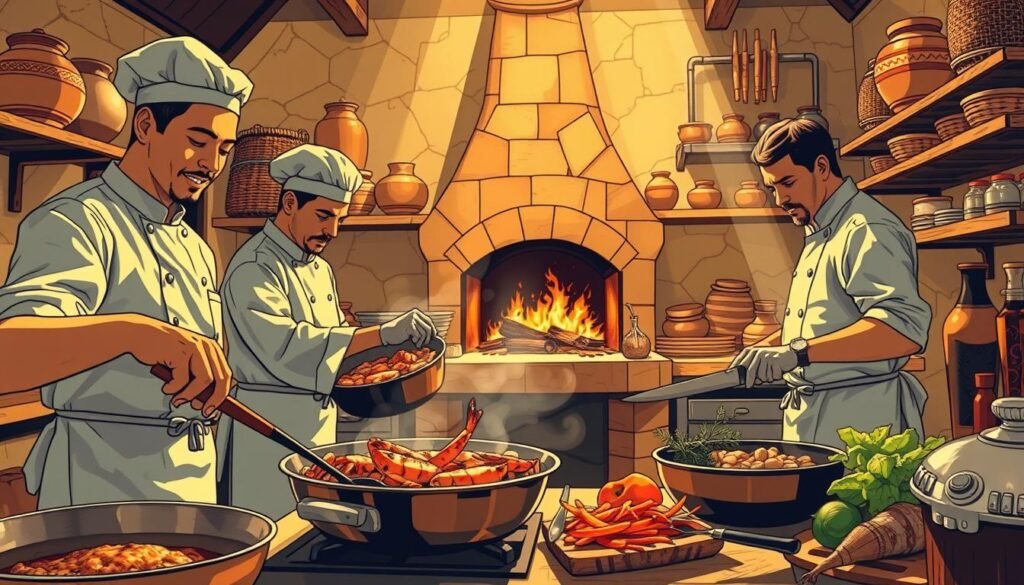
Introduction of Sautéing, Stewing, and Roasting
Sautéing, a method introduced by the Spanish, became a cornerstone of many dishes. Using garlic, onion, and oil, this technique enhanced the flavors of meats and vegetables. It laid the groundwork for popular stews like adobo, which combines vinegar, soy sauce, and spices.
Stewing, another Spanish contribution, allowed for slow-cooked meals that were both hearty and flavorful. Dishes like puchero and caldereta showcase this method, blending local ingredients with Spanish influences. The use of tomatoes and spices added depth to these recipes.
Roasting, particularly for festive dishes, became a symbol of celebration. The preparation of lechon, a whole roasted pig, highlights this technique. The marinating process often includes local spices, creating a perfect blend of traditions.
“The Spanish methods of cooking brought a new dimension to local cuisine, blending simplicity with rich flavors.”
| Method | Key Ingredients | Example Dish |
|---|---|---|
| Sautéing | Garlic, onion, oil | Adobo |
| Stewing | Tomatoes, spices | Caldereta |
| Roasting | Pork, local spices | Lechon |
These methods have been seamlessly integrated into local cooking, preserving their Spanish roots while adapting to Filipino tastes. From everyday meals to festive feasts, the influence of these techniques is undeniable.
Key Spanish Techniques Impacting Filipino Dishes
Spanish influence brought new flavors and techniques that transformed traditional recipes. The introduction of ingredients like soy sauce and vinegar reshaped the way meals were prepared, creating a unique blend of flavors. These additions became essential in many iconic dishes, showcasing the adaptability of local cooking.
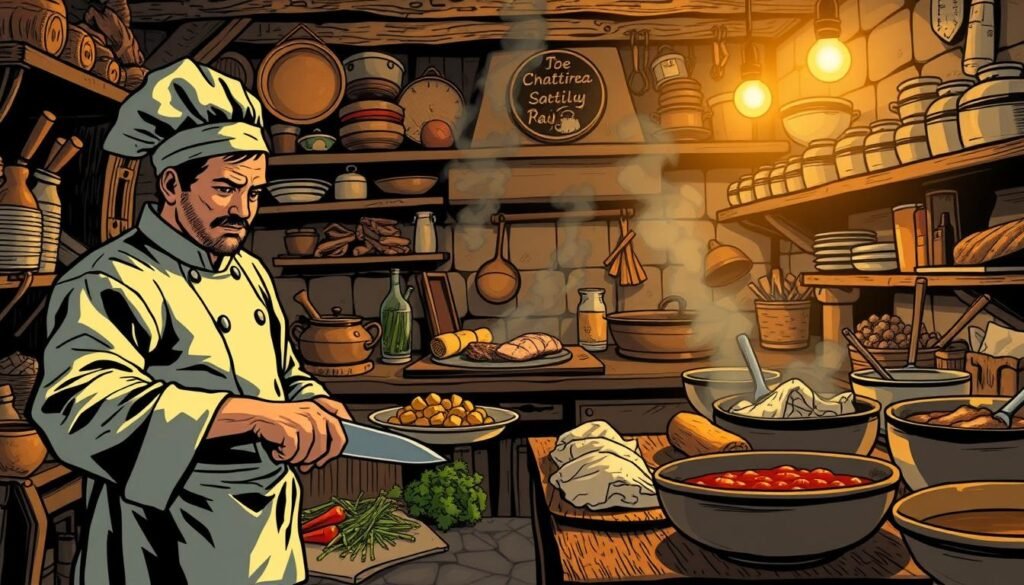
Adoption of New Ingredients and Flavors
One of the most significant contributions was the use of vinegar and soy sauce in marinating and preserving food. These ingredients added depth and complexity to dishes like adobo, a stew that combines meat, garlic, and spices. The tangy and savory flavors became a hallmark of Filipino cooking.
Spanish methods like sautéing and stewing were also adopted, enhancing the preparation of local recipes. For example, the use of tomatoes in sauces brought a richness to dishes like caldereta. These techniques allowed for greater creativity while staying true to traditional flavors.
The fusion of Spanish and local practices led to the creation of dishes that are now staples in Filipino cuisine. From festive lechon to everyday adobo, these recipes reflect a rich cultural exchange. The blending of ingredients and methods continues to inspire modern interpretations.
| Ingredient | Technique | Example Dish |
|---|---|---|
| Vinegar | Marinating | Adobo |
| Soy Sauce | Stewing | Caldereta |
| Tomatoes | Sautéing | Afritada |
Today, these adopted techniques remain central to Filipino cooking. They highlight the adaptability and innovation of local chefs, ensuring that traditional flavors continue to thrive in modern kitchens.
Modern Adaptations of Traditional Methods
In today’s kitchens, traditional methods meet modern innovation, creating a dynamic culinary landscape. Chefs are reinterpreting age-old practices while embracing new tools and ideas. This blend of old and new ensures that the essence of flavor remains intact while pushing boundaries in presentation and sustainability.

Contemporary Techniques Blending Old and New
Modern cooks are finding creative ways to update classic recipes. For example, dishes like adobo are being reinvented with new ingredients or cooking methods. Chefs like Chele Gonzáles have gained recognition for their ability to merge traditional flavors with modern techniques, as seen in dishes that highlight local ingredients with global appeal.
Sustainability is a key focus in these adaptations. Chefs are sourcing ingredients responsibly, reducing waste, and using eco-friendly practices. This approach not only preserves the environment but also enhances the quality of the meal.
Technology plays a significant role in modernizing traditional methods. Tools like sous-vide machines and precision ovens allow for greater control over cooking processes. These advancements ensure that dishes like lechon retain their authenticity while achieving consistent results.
| Traditional Dish | Modern Adaptation | Key Technique |
|---|---|---|
| Adobo | Adobo Chocolate Chip Cookies | Baking |
| Kinilaw | Seared Kangaroo Kinilaw | Seared Raw Preparation |
| Sinigang | Deconstructed Sinigang | Molecular Gastronomy |
Creative presentation is another hallmark of modern adaptations. Chefs are using artistic plating techniques to elevate dishes like sinigang or pancit. This approach not only enhances the visual appeal but also makes the dining experience more memorable.
Despite these innovations, the heart of the cuisine remains unchanged. The use of staples like rice and chicken continues to connect modern dishes to their roots. This balance between tradition and innovation ensures that the flavors of the past are preserved for future generations.
Regional Variations in Filipino Recipes
The Philippines’ diverse geography has shaped its regional recipes in unique ways. From the hearty dishes of the north to the fresh flavors of the Visayas, each area offers a distinct cooking style. These variations highlight how local ingredients and traditions influence the way meals are prepared.
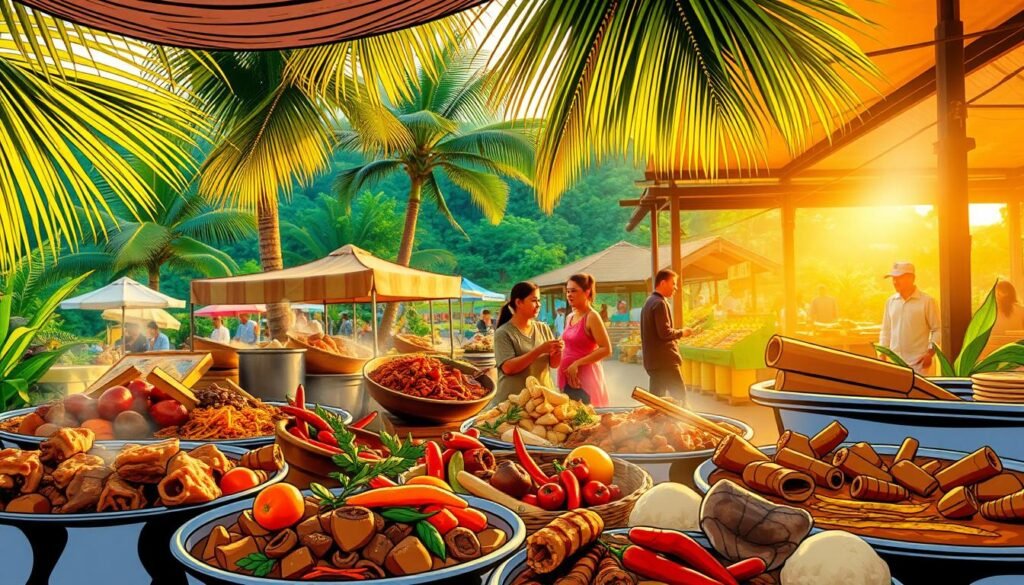
Northern Flavors and Unique Preparations
In the northern regions, dishes often feature robust ingredients like beef and root crops. The cooler climate and fertile soil contribute to hearty meals such as bagnet (crispy pork belly) and pinakbet (a vegetable stew). These recipes showcase the resourcefulness of local cooks, who use what’s available to create flavorful dishes.
Northern methods often involve slow cooking or frying to enhance the natural taste of ingredients. For example, bagnet is deep-fried to achieve its signature crunch, while pinakbet is simmered to blend the flavors of vegetables and shrimp paste. These techniques reflect the region’s focus on simplicity and depth of flavor.
Visayan Delicacies and Coastal Influences
The Visayas, with its coastal location, emphasizes fresh seafood and light preparations. Dishes like kinilaw (raw fish marinated in vinegar) and inasal (grilled chicken) highlight the region’s access to the sea and its vibrant culinary tradition. These recipes often feature tangy and savory flavors, reflecting the area’s tropical environment.
Coastal influences bring a distinct freshness to Visayan fare. For example, kinilaw uses citrus and vinegar to “cook” the fish, preserving its natural texture. Meanwhile, inasal is marinated with local spices and grilled over charcoal, creating a smoky and aromatic dish. These methods showcase the region’s ability to adapt classic recipes to its unique resources.
Whether you’re dining in a northern restaurant or enjoying a Visayan feast, these regional variations offer a glimpse into the Philippines’ rich culinary heritage. Each dish tells a story of local ingredients, cooking techniques, and the people who bring them to life.
Fermentation and Preservation in Filipino Cuisine
Preserving food has always been a cornerstone of Filipino culture, ensuring meals last longer and flavors deepen. Before modern refrigeration, techniques like fermentation, smoking, and sun-drying were essential for extending shelf life. These methods not only preserved food but also added unique flavors that define many traditional dishes.
Fermentation, in particular, plays a vital role in creating signature flavors. Ingredients like fish are often marinated in vinegar or salt, producing tangy and savory results. This method is seen in dishes like bagoong, a fermented shrimp paste that adds depth to many recipes. The process of fermentation also enhances nutritional value, making it a practical and healthy choice.
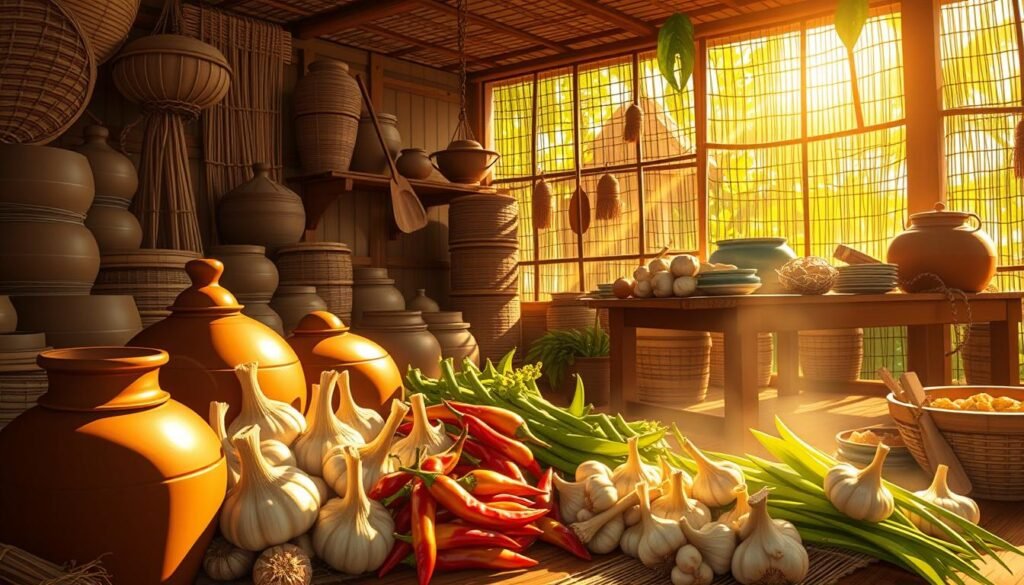
Smoking, known as tinapa, is another traditional preservation technique. Fish is cured with salt and then smoked over wood, giving it a distinct smoky flavor. This method is especially popular in coastal regions, where fresh seafood is abundant. Sun-drying is also widely used, particularly for meats and fish, creating a chewy texture and concentrated taste.
Historically, these techniques were crucial for survival, especially in areas without access to ice or refrigeration. They allowed communities to store food for long periods, ensuring a steady supply during lean seasons. Today, these practices continue to thrive, connecting modern kitchens to their cultural roots.
Regional variations highlight the adaptability of these methods. In the Ilocos region, vinegar is a staple for both preservation and seasoning. Meanwhile, the Visayas are known for their fermented coconut sap, tuba, which is rich in nutrients. These regional specialties showcase the diversity of Filipino cuisine and its deep ties to local resources.
For a deeper dive into the world of Philippine ferments, explore how these traditional practices continue to shape the culinary landscape.
| Method | Key Ingredient | Resulting Dish |
|---|---|---|
| Fermentation | Fish, Vinegar | Bagoong |
| Smoking | Fish, Salt | Tinapa |
| Sun-Drying | Meat, Fish | Dried Tuyo |
These preservation techniques are more than just practical solutions—they are a celebration of culture and community. Whether it’s a family gathering or a festive celebration, these methods ensure that traditional flavors remain at the heart of every meal.
Family and Community in Culinary Traditions
Family and community are the heart of every meal in the Philippines. The kitchen is more than just a place to cook; it’s where stories, flavors, and traditions come alive. Through shared meals, families strengthen bonds and preserve their cultural heritage.
Recipes are passed down through generations, ensuring that each dish carries the warmth of family. Grandmothers teach their grandchildren the perfect way to marinate meat or the right amount of pepper to add. These lessons are more than just instructions; they are a legacy that connects the past to the present.
Passing Down Recipes Through Generations
In many households, cooking is a collaborative effort. Parents and children work together to prepare meals, sharing stories and techniques along the way. This practice not only preserves culinary knowledge but also fosters a sense of belonging.
Community gatherings are another way traditions are kept alive. Festivals and family reunions often feature dishes like adobo and sinigang, which are prepared using recipes handed down for generations. These events highlight the importance of food in bringing people together.
Even in modern times, the essence of these traditions remains intact. Families adapt recipes to suit contemporary tastes while staying true to their roots. This balance ensures that the flavors of the past continue to thrive in today’s kitchens.
| Tradition | Role | Example |
|---|---|---|
| Recipe Sharing | Preserves knowledge | Adobo recipe |
| Community Gatherings | Strengthens bonds | Festival meals |
| Modern Adaptations | Maintains relevance | Updated sinigang |
For more insights into how food strengthens family and community ties, explore this resource.
Signature Dishes: Adobo, Sinigang, and Beyond
The flavors of the Philippines are deeply rooted in its history and culture. Among the many dishes that define its cuisine, adobo and sinigang stand out as cornerstones. These recipes reflect centuries of cultural blending, combining native ingredients with foreign influences to create dishes that are both comforting and iconic.
Adobo: A Blend of Vinegar, Soy, and Spanish Techniques
Adobo is often considered the unofficial national dish of the Philippines. Its simplicity lies in its key ingredients: vinegar, soy sauce, garlic, and spices. The method involves marinating meat—often chicken or pork—in this mixture before simmering it to perfection. This cooking technique not only tenderizes the meat but also infuses it with a rich, savory flavor.
The origins of adobo can be traced back to Spanish colonization, where the term “adobo” referred to a marinade or seasoning. However, the dish itself predates this era, showcasing the adaptability of local recipes. Today, adobo is enjoyed in countless variations, each reflecting regional tastes and family traditions.
Sinigang: The Tangy Comfort of Filipino Culinary Heritage
Another beloved filipino dish is sinigang, a tangy soup that offers a refreshing contrast to richer meals. Its signature sourness comes from ingredients like tamarind, kamias, or green mango. Common proteins include pork, shrimp, or fish, while vegetables like bean sprouts, eggplant, and kangkong add texture and depth.
Sinigang’s appeal lies in its versatility and comforting nature. It’s often enjoyed during the rainy season or colder months, providing warmth and nourishment. The dish’s roots are deeply tied to indigenous cooking, with its souring agents and preparation methods reflecting local ingenuity.
| Dish | Key Ingredients | Signature Flavor |
|---|---|---|
| Adobo | Vinegar, soy sauce, garlic | Savory and tangy |
| Sinigang | Tamarind, pork, vegetables | Tangy and refreshing |
Both adobo and sinigang highlight the Philippines’ ability to blend tradition with innovation. Whether served at family gatherings or enjoyed in modern interpretations, these dishes continue to captivate both locals and global audiences. Their enduring popularity is a testament to the rich culinary heritage they represent.
Evolving Culinary Vocabulary in Filipino Cooking
Language plays a vital role in preserving the essence of a country’s food culture. Over time, the way we describe cooking techniques has evolved, reflecting historical influences and modern adaptations. Understanding these terms helps us appreciate the depth of traditional recipes and their cultural significance.
Historically, indigenous words like prito (fry) and ginisa (sauté) have been used to describe common cooking methods. These terms highlight the simplicity and resourcefulness of early cooks. For example, prito involves frying food in oil, while ginisa uses garlic, onion, and oil to enhance flavors.
Spanish colonization introduced new terms and techniques, blending with local practices. Words like adobo and caldereta became part of the culinary lexicon, showcasing the fusion of cultures. This blending of languages not only enriched the vocabulary but also preserved the heritage of traditional dishes.
Modern interpretations have further influenced culinary terminology. Chefs and food enthusiasts often use innovative terms to describe updated recipes. For instance, deconstructed sinigang reflects a contemporary take on a classic dish, while still honoring its roots.
Preserving indigenous vocabulary is crucial for maintaining cultural identity. Words like kinilaw (marinated raw fish) and tinapa (smoked fish) connect us to the past, ensuring that traditional methods are not forgotten. These terms also highlight the importance of local ingredients, such as water and seafood, in shaping the cuisine.
“The way we describe cooking reflects the history and evolution of a nation’s cuisine.”
To explore how language continues to shape food culture, visit this resource on the influence of the Filipino language on culinary traditions.
From ancient terms to modern adaptations, the culinary vocabulary of the Philippines tells a story of resilience and innovation. By understanding these words, we gain a deeper appreciation for the rich heritage behind every dish.
Authenticity in Filipino Home-Cooked Meals
At the heart of every Filipino home, the kitchen is a place where memories are made and traditions are kept alive. Home-cooked meals are more than just food—they are a reflection of love, history, and identity. From Luzon to the Visayas, each family’s recipe carries a unique story, passed down through generations.
What makes these meals authentically Filipino is their simplicity and deep connection to tradition. Ingredients like garlic, onions, and vinegar are staples, often sourced locally to ensure freshness. These elements, combined with ancestral techniques, create dishes that are both comforting and meaningful.
Every meal is a labor of love, prepared with pride and passion. Families gather to cook together, sharing stories and laughter. This communal practice strengthens bonds and ensures that cultural heritage is preserved. Whether it’s a weekday dinner or a festive feast, the kitchen remains the heart of the home.
Authenticity is also rooted in personal memories. A grandmother’s adobo or a father’s sinigang carries the flavors of childhood and the warmth of family. These dishes are not just recipes—they are a testament to the resilience and creativity of Filipino culture.
From the bustling markets of Luzon to the coastal kitchens of the Visayas, home-cooked meals celebrate the diversity of the Philippines. They remind us that food is more than sustenance—it is a way of life, a connection to the past, and a gift to the future.
Celebrating Culinary Traditions in Filipino Festivals
Festivals in the Philippines are a vibrant celebration of culture, where food takes center stage. These events bring together families and communities, showcasing the rich heritage of the nation through shared meals and traditional dishes. From the bustling streets of Batangas to the coastal towns of Samar, each festival tells a story of tradition and unity.
The Role of Community Feasts and Family Gatherings
At the heart of every festival is the communal feast, where everyone contributes to the preparation and enjoyment of the meal. Families gather to cook together, passing down recipes and techniques that have been cherished for generations. This practice not only strengthens bonds but also ensures that cultural knowledge is preserved.
Large community feasts are a hallmark of Filipino celebrations. Dishes like lechon (roasted pig) and adobo (marinated meat) are often served, symbolizing abundance and hospitality. These meals are more than just nourishment; they are a testament to the spirit of togetherness that defines Filipino culture.
“Festivals are a time to celebrate our heritage, and food is the language through which we express our gratitude and joy.”
Traditional dishes also carry deep symbolism. For example, the longganisa (sausage) served during the Longganisa Festival in Vigan represents the region’s agricultural roots. Similarly, the tuna dishes at the Tuna Festival in General Santos City highlight the city’s thriving fishing industry.
| Festival | Signature Dish | Symbolism |
|---|---|---|
| Lechon Festival | Lechon | Abundance and celebration |
| Tuna Festival | Tuna dishes | Marine resources and livelihood |
| Longganisa Festival | Longganisa | Agricultural heritage |
These festivals not only celebrate local produce but also reinforce cultural identity. They remind us of the importance of preserving our traditions while embracing the diversity of our culinary heritage. For more insights into how food brings communities together, explore this resource on Filipino market fiestas.
Through these celebrations, we see how food serves as a bridge between the past and the present, connecting generations and fostering a sense of belonging. Whether it’s a simple family gathering or a grand community feast, these traditions continue to shape the way we celebrate and honor our culture.
Future Trends and Innovations in Filipino Cuisine
The future of food in the Philippines is being shaped by innovation and sustainability. As the world evolves, so does the way we prepare and enjoy our meals. Modern kitchens are embracing new trends while staying true to traditional roots, creating a dynamic culinary landscape that respects heritage while embracing change.
Modern Influences and Sustainable Practices
One of the most significant trends is the rise of sustainable practices in local kitchens. Chefs are increasingly focusing on reducing waste and sourcing ingredients responsibly. For example, dishes like Dinakdakan Tacos creatively utilize every part of the pig, promoting low-waste dining. This approach not only supports local farming communities but also aligns with global efforts to combat food waste.
Health-conscious adaptations are also gaining traction. Traditional dishes are being reimagined with nutritious ingredients, catering to evolving consumer preferences. Plant-based versions of classics like lumpia and lechon are becoming popular, offering healthier alternatives without compromising on flavor.
| Trend | Example | Impact |
|---|---|---|
| Sustainability | Low-waste dishes | Reduces environmental footprint |
| Health-conscious | Plant-based lumpia | Promotes healthier eating |
| Innovation | Adobo tacos | Blends tradition with modern flavors |
Innovations in food technology are also transforming the way we cook. Techniques like molecular gastronomy and fermentation are being applied to traditional recipes, enhancing both flavor and nutritional value. For instance, modern fermentation methods are increasing the probiotic content in dishes, offering additional health benefits.
The farm-to-table movement is another trend reshaping the culinary scene. By emphasizing local sourcing, restaurants are ensuring fresher ingredients while supporting local farmers. This approach not only improves the quality of meals but also strengthens the connection between producers and consumers.
“The blending of tradition and innovation ensures that Filipino cuisine remains relevant in a rapidly changing world.”
As the Philippines continues to evolve, its culinary traditions will undoubtedly adapt to meet new challenges and opportunities. By embracing sustainable practices and innovative techniques, the future of Filipino food looks bright, promising a delicious and eco-friendly dining experience for generations to come.
For more insights into the rise of modern Filipino cuisine, explore this resource on how chefs are blending traditional flavors with contemporary techniques.
Conclusion
The rich tapestry of Filipino food reflects centuries of cultural exchange and innovation. From the introduction of Spanish cooking techniques to the resilience of indigenous practices, the evolution of these dishes is a testament to adaptability. Iconic recipes like adobo and sinigang showcase the seamless blend of tradition and creativity, making every meal a celebration of heritage.
Modern kitchens continue to honor these roots while embracing sustainable practices and innovative methods. Whether it’s a classic chicken dish or a contemporary twist, the essence of Filipino cuisine remains deeply connected to its history. This living tradition invites everyone to explore and experiment, ensuring its flavors thrive for generations.
To delve deeper into the significance of these culinary practices, explore how Filipino condiments preserve cultural identity and enhance flavors. Celebrate the artistry of local cooking and discover the stories behind every dish.
FAQ
How did Spanish colonization influence cooking in the Philippines?
Spanish colonization introduced techniques like sautéing, stewing, and roasting. It also brought new ingredients such as tomatoes, garlic, and olive oil, which became staples in many dishes.
What are some traditional methods still used today?
Traditional methods like fermentation, grilling, and steaming remain popular. These techniques are often used in dishes like kinilaw (ceviche) and inasal (grilled chicken).
What role does vinegar play in Filipino cooking?
Vinegar is a key ingredient in many recipes, providing tanginess and acting as a preservative. It’s essential in dishes like adobo and paksiw.
How do regional variations affect Filipino recipes?
Regional variations bring diversity to the cuisine. Northern Luzon often uses hearty stews, while Visayan regions focus on seafood and coconut-based dishes.
What are some signature dishes that showcase these techniques?
Adobo, sinigang, and lechon are iconic dishes. Adobo combines vinegar and soy sauce, sinigang features tamarind for sourness, and lechon highlights roasting techniques.
How are culinary traditions preserved in Filipino families?
Recipes are often passed down through generations, with families gathering to cook and share meals during celebrations and festivals.
What modern trends are shaping Filipino cuisine today?
Modern trends include fusion dishes, sustainable practices, and the use of local, organic ingredients to innovate while honoring tradition.
Source Links
- The Story of Filipino Cuisine: A Culinary Journey Through History
- The Spanish Influence on Filipino Culture and Language
- Filipino Cuisine: A Rich Tapestry Of Culinary Traditions
- Filipino Food Cooking Techniques
- Traditional Filipino Cooking Methods
- The Original Fusion Food: Filipino Food Culture
- How Traders, Travelers and Colonization Shaped Filipino Cuisine
- The History and Culture of Filipino Cuisine: A Culinary Journey Through Time | Tofuichiban
- The Spanish Influence on Filipino Cuisine
- 13 Filipino Dishes With Hispanic Influence – Tasting Table
- How Spanish Cuisine Shaped Filipino Food: A Culinary Exploration – Islands Philippines
- Traditional Cooking Methods in Filipino Food Culture
- Exploring Philippine Cuisine: A Culinary Experience
- Philippine cuisine
- Filipino food: a cuisine of many influences
- Fiestas and Filipino Food: A Legacy of Spanish Catholicism – pinascuisine.com
- The next generation of Filipino food – IFEXConnect
- Detailed Guide to Local Cuisine of the Philippines: Traditional Filipino Food & Delicacies | Guide to the Philippines
- Breaking down Filipino cuisine by region is harder than you’d think
- 15 Books on Filipino Food by Region: A Short Guide
- The Hidden Gems of Filipino Regional Dishes
- A history of fermentation in Philippine cuisine
- Lactic Acid Bacteria in Philippine Traditional Fermented Foods
- Memories on the Plate: Filipino Culture and Food in the Diaspora
- Adobo: The Heart of Filipino Cuisine
- Tasting History: How Kapampangan Recipes Reflect Cultural Heritage
- 11 traditional Filipino cooking techniques that aren’t adobo and sinigang
- Philippine Culinary Identity : Sinigang or Adobo ?
- From Adobo to Sinigang: A Foodie’s Guide to the Best Filipino Cuisine – Secret Philippines
- Filipino cuisine
- Discovering Traditional Filipino Cuisine: Indulge in Authenticity
- Filipino Cuisine: Discover Authentic Flavors and Recipes – pinoyhelper.com
- The Art of Authentic Filipino Cuisine: A Guide to Traditional Dishes
- 11 Major Food Festivals in the Philippines
- A journey to Filipino culinary traditions at Palenque – Foodie
- Filipino Cuisine: A Culinary Journey Through the Philippines
- Future Filipino Food Trends Come to Light at Hilton Manila’s Kusina Sea Kitchens
- Revolutionizing the Philippines’ food industry: Unleashing innovation and technology – TNGlobal
- The Future of Filipino Food and Health: Research and Innovation – pinascuisine.com
- Food Culture of the Philippines: Exploring Filipino Cuisine | Discover by Silversea

